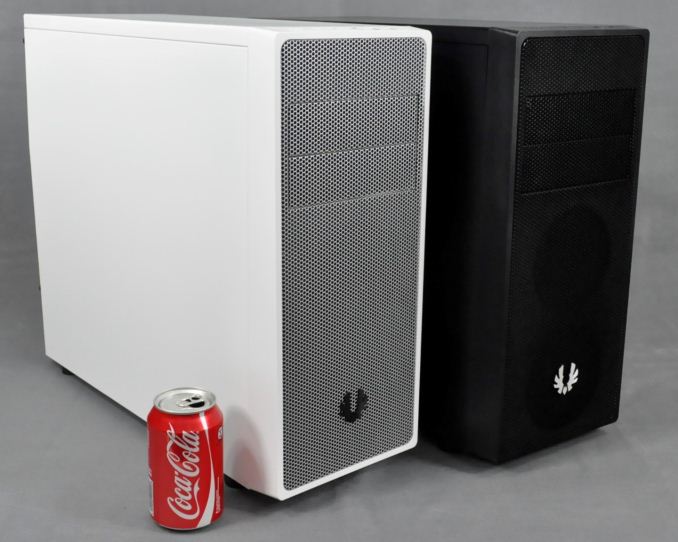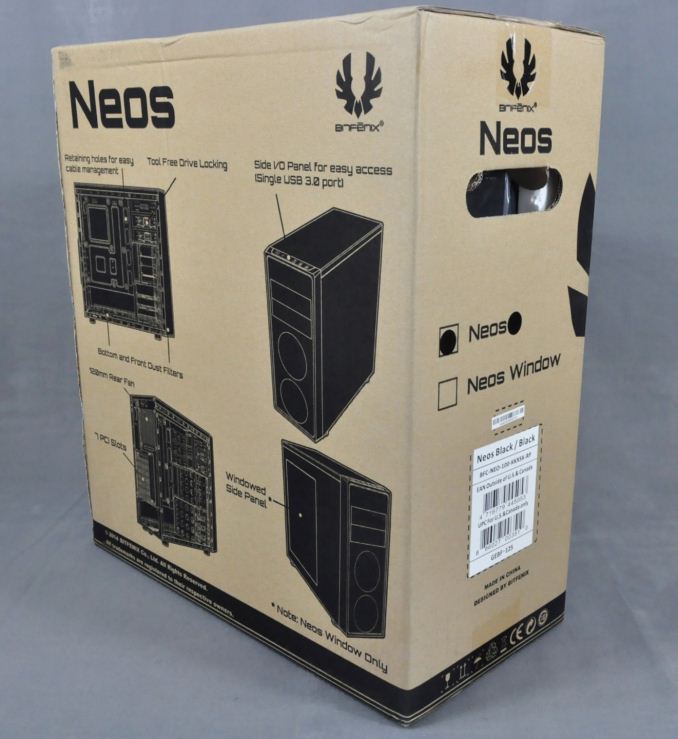BitFenix Neos Case Review
by E. Fylladitakis on January 21, 2015 9:00 AM EST- Posted in
- Cases/Cooling/PSUs
- bitfenix
- Case

Introduction
Naturally, most manufacturers are inclined to have their best products reviewed, as a high-cost product is less likely to have many flaws and it's easy to leave the average user awestruck, promoting the company name. However, the bulk of the revenue of most companies comes from their "mainstream" products, where the target market is many times larger than that of enthusiasts and highly advanced users. In the past several months, we've had the chance to have a look at several advanced cases, some designed for performance while others were meant for special applications. Today we are going to have a look at a standard Mid-ATX case with a price tag of about $60, the BitFenix Neos.
BitFenix is no stranger to AnandTech. Many of their products have been through our labs, from the $39 Merc Alpha to the $159 Shinobi XL, each with its own target group, strengths, and weaknesses. The BitFenix Neos that we are reviewing today aims to be an affordable, simple, and stylish case. It can be found selling from about $50 to $75, depending on the color configuration. Two chassis are available, either black or white, but there is a large selection of faceplate/mesh colors for either chassis, including black, white, red, bronze, silver, gold, blue, and purple.
12 oz. Coke can for size comparison.
| >BitFenix Neos Specifications | ||
| Motherboard Form Factor | ATX, Micro-ATX, Mini-ITX | |
| Drive Bays | External | 2 x 5.25" |
| Internal | 3 x 3.5" (front drive cage) 3 x 2.5" (front drive cage) | |
| Cooling | Front | 2 x 120 mm (optional) |
| Rear | 1 x 120 mm (included) | |
| Top | - | |
| Left Side | - | |
| Bottom | - | |
| Radiator Support | Front | - |
| Rear | 120 mm | |
| Top | - | |
| Side | - | |
| Bottom | - | |
| I/O Port | 1x USB 3.0, 1x USB 2.0, 1x Headphone, 1x Mic | |
| Power Supply Size | ATX | |
| Clearances | HSF | 155 mm |
| PSU | - | |
| GPU | 310 mm | |
| Dimensions | 429 mm × 185 mm × 470 mm (H×W×D) 16.89 in × 7.28 in × 18.5 in (H×W×D) | |
| Prominent Features | Front Dust Filter PSU Dust Filter Tool-Free Drive Locking | |
| Price | $50 to $75, depending on the color configuration | |
Packaging and Bundle
BitFenix supplies the Neos in colorless, brown cardboard boxes. Illustrations on the box depict the most important features of the case. Inside the box, the lightweight case is very well protected by thick styrofoam slabs and a nylon bag. As for the bundle, we are not going to delve much into it, simply because there is virtually nothing noteworthy supplied with the Neos. With the purchase of this case, the user will only receive a basic manual and the necessary screws in a small nylon bag.












54 Comments
View All Comments
Oxford Guy - Wednesday, January 21, 2015 - link
You can get a case for $25 that can be used for a low wattage system. Why spend so much on this? It doesn't have good cable management, etc.SleepModezZ - Wednesday, January 21, 2015 - link
In the shop that I usually buy from the cheapest midi/mini case (for full ATX-motherboards) is 33€ (LC-Power 3001B). Neos (without a window) is 41€. Scrolling the list down from cheapest to more costly, the Neos is the first to give some aesthetic pleasure because its color options. That could decide it for some. You can choose a case that fits the room it will be in. Cable management is not really so important if you have a low wattage system in a windowless case. (I don't really understand the window option on a case like Neos.)E.Fyll - Thursday, January 22, 2015 - link
A lower thermal load would yield correlative results, just at a lower magnitude and over a significantly longer period of time. That is why every comparison of cases using either the 850W and 400W load charts always ends up the same. Regardless of the thermal load, given that we are talking about a passive load, if case A is better than case B, it will always be better than case B - only the magnitude of the results changes.We are using the 400W load only because there are some cases (like this one) that cannot handle a very high thermal load at all without starting a fire. With the 400W load requiring a time of at least seven hours to give usable results, testing with a lower load is unfeasible - it would take days and I cannot keep the ambient conditions stable for that long. Furthermore, a very low load would bring the results of many cases very close together, making them look virtually identical, because of the shrinkage of the scale. My equipment can tell the difference between 41°C and 42°C, but not between 20°C and 20.02°C.
SleepModezZ - Thursday, January 22, 2015 - link
Thank you for your answer - and for the review. You are right that it makes sense to test in the way you do. The problem is more in the conclusions that seems to be derived from that - or maybe just the emphasis on that one fact. At a low thermal load the case will still be worse thermal wise than the bigger and more expensive comparisons - but in practice the difference won't matter much. Other factors will easily overrun that drawback for a potential buyer who is not interested in building a gaming rig into the case.It seems that you did not like the looks of the case. I have not seen it in person so I can't make a comment. Still, it has several color options to choose from whereas probably every else case in the same form factor and price group comes without such choice. I, for one, would easily pay 50% more (or accept other drawbacks) to get a case in the most pleasing color option. It will be a part of the furniture for some years so the exterior appearance, in the context of the room where it will be sitting in, is very important. I don't know if BitFenix was the first to offer cases with color options - more than a black and a white option, or a black and an aluminium/silver option - but they are currently very prominent in that - and I really appreciate that.
Antronman - Wednesday, January 21, 2015 - link
Scorching review. All you need is some obscene language and I'd think Chef George Ramsay wrote this.Antronman - Wednesday, January 21, 2015 - link
Fuck Gordon Ramsay wtf was I doingmakerofthegames - Wednesday, January 21, 2015 - link
tl;dr version: BitFenix finally fucked one up.wbwb - Wednesday, January 21, 2015 - link
This is a fine-looking, solidly built case for a basic PC with a quad core CPU and a single GPU, i.e. a 450 watt system. I built one last month. Not every case has to be designed to support overclocking and radiators or monstrous heatsinks. If you want that, there are plenty of other cases to choose from, and stop kidding yourself, you're not going to buy a $60 case anyway.chlamchowder - Wednesday, January 21, 2015 - link
The problem is, there are $60 cases (Corsair 200R, NZXT Source 220, and probably some others) that can take radiators or bigger heatsinks, and look like decent options even for overclocking.If you want to overclock, and want radiators/big heatsinks, and can get a case that supports that for $60 or even less, why not do that?
lazymangaka - Saturday, January 24, 2015 - link
If you know you want to overclock and think the possibility of radiators or big heatsinks is in your future, you should probably choose a case that reflects that.This case isn't for that. It doesn't (to the best of my knowledge) claim to be that. This is the sort of case for the build you do for a parent, sibling, or significant other that is built once then not touched for years. The sort of build where the looks of the case are more important than the convenience of the cable management.